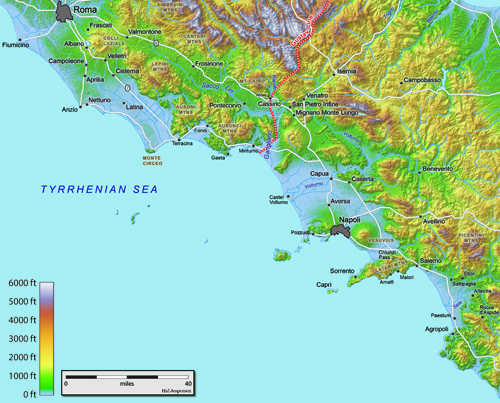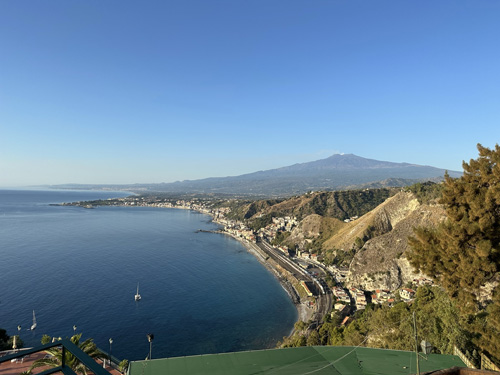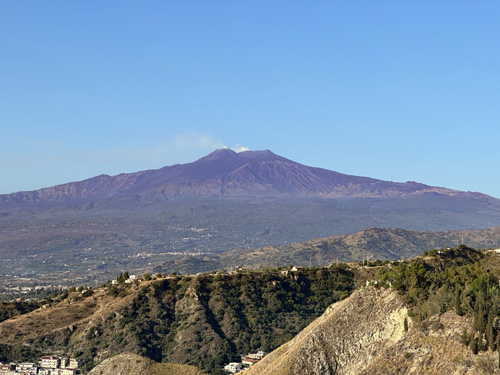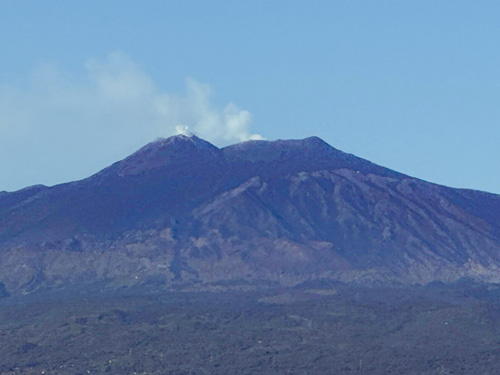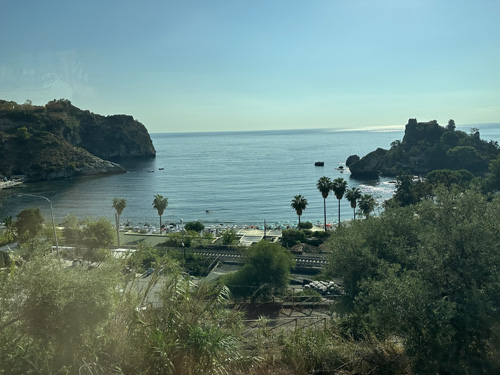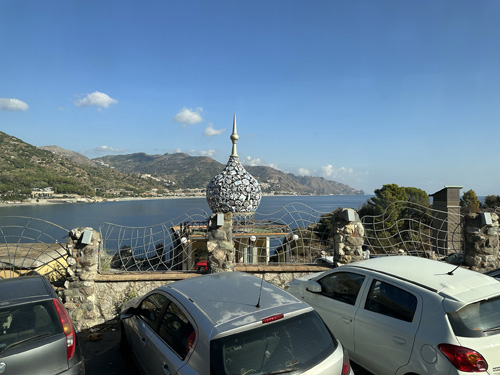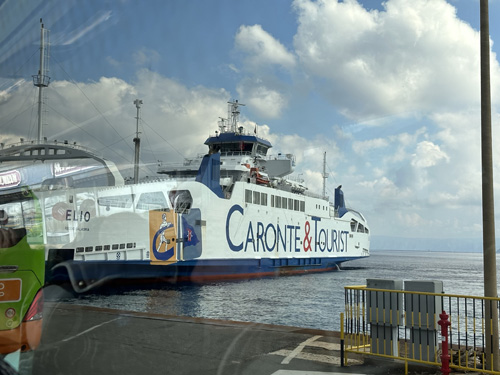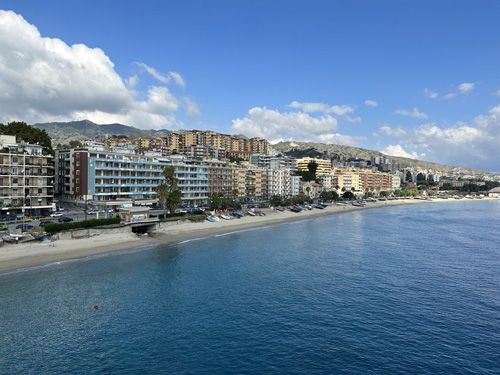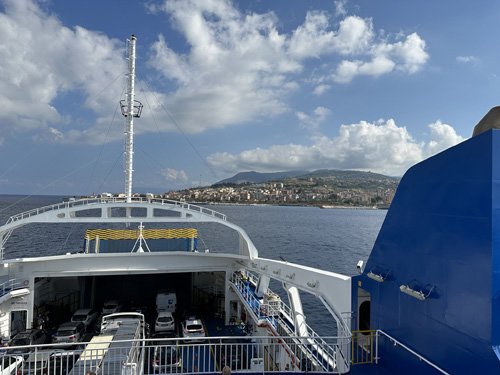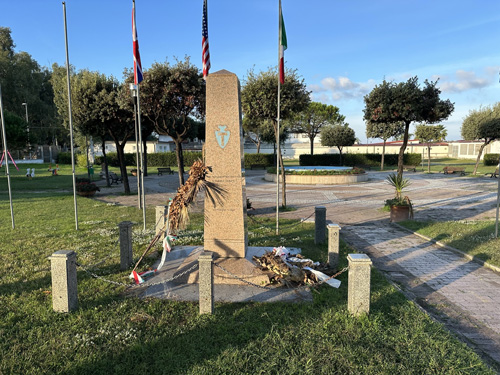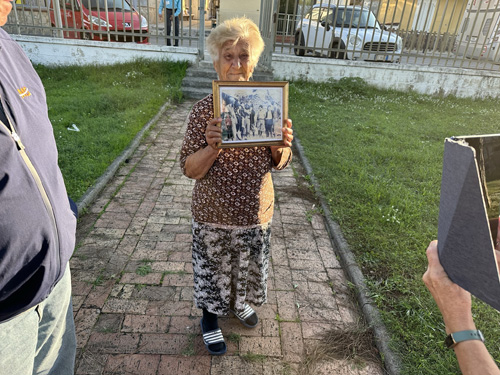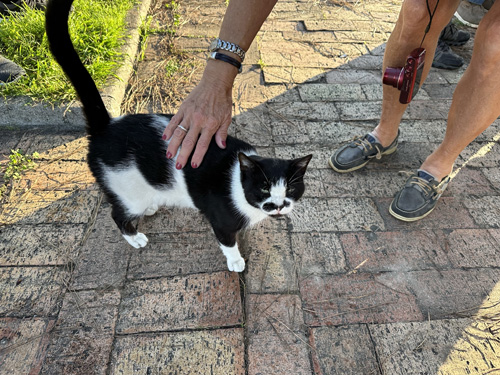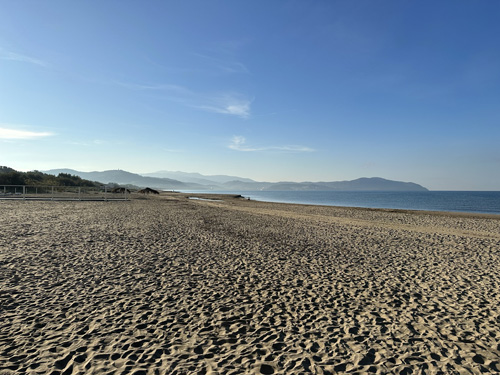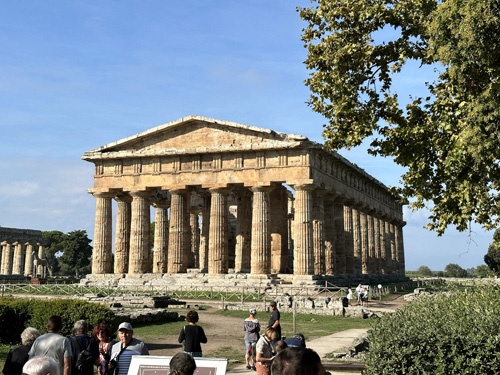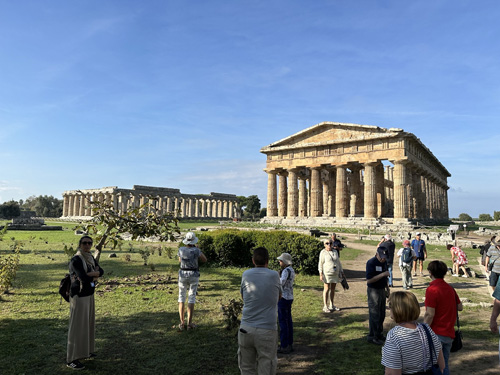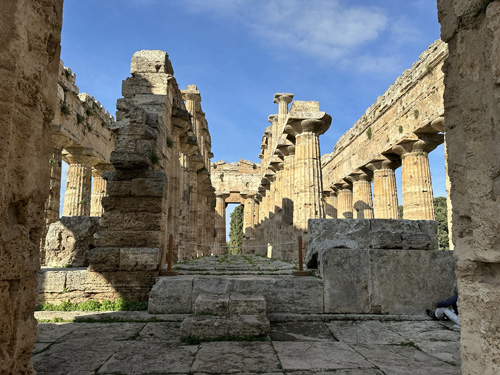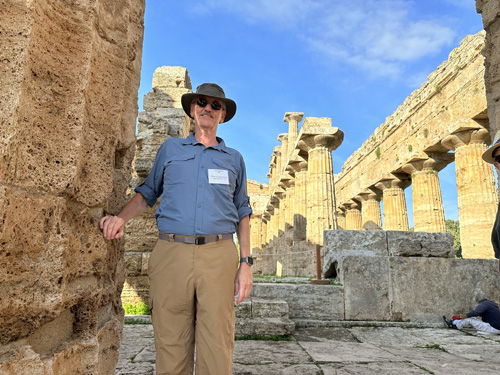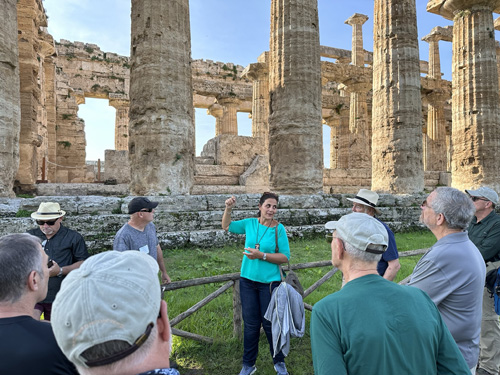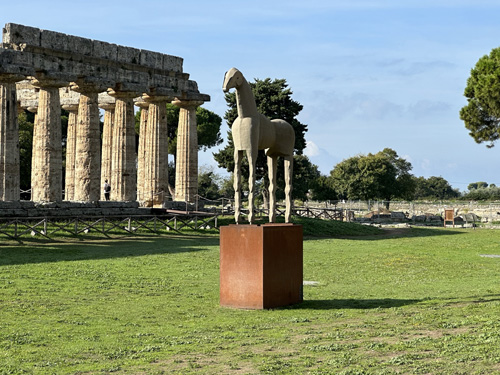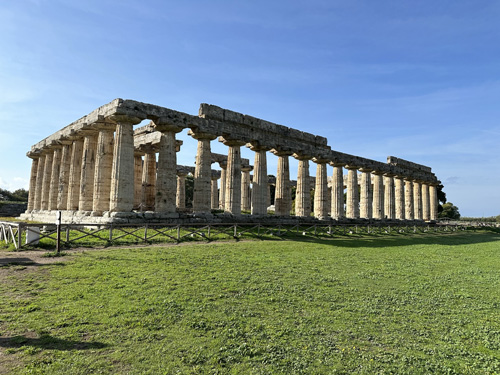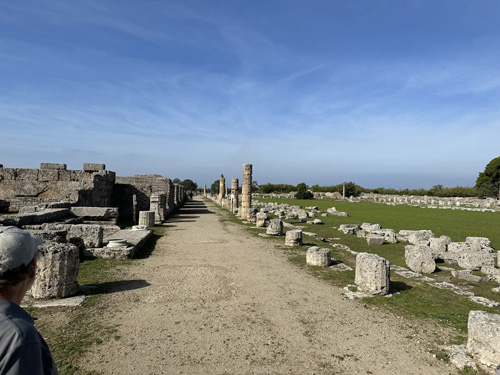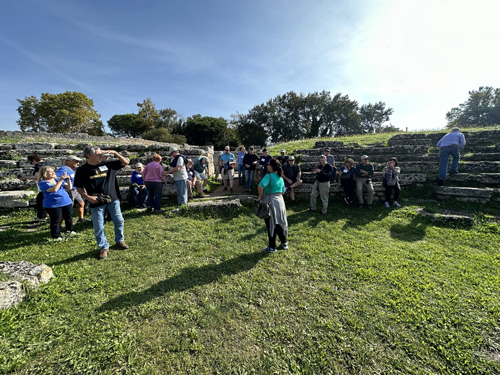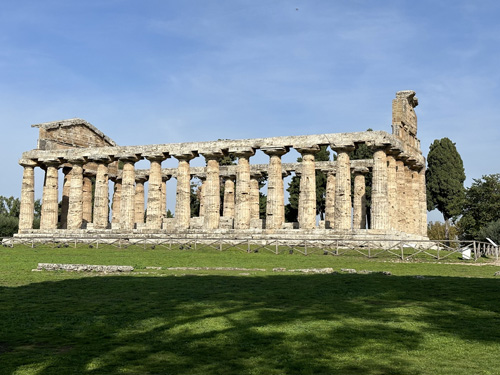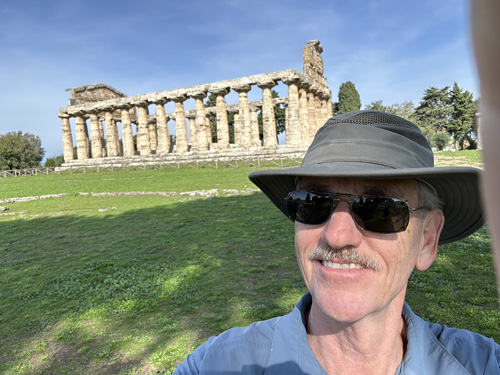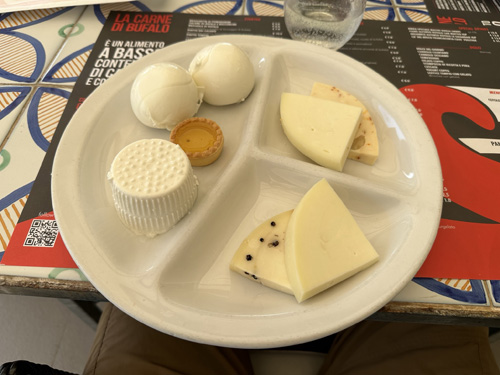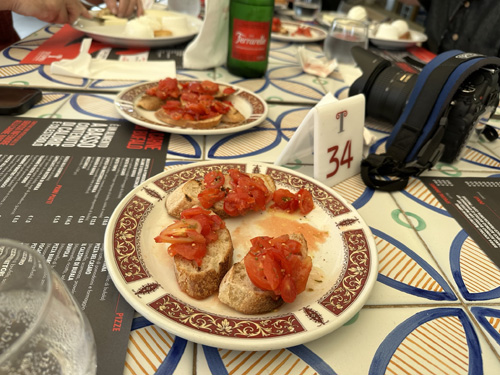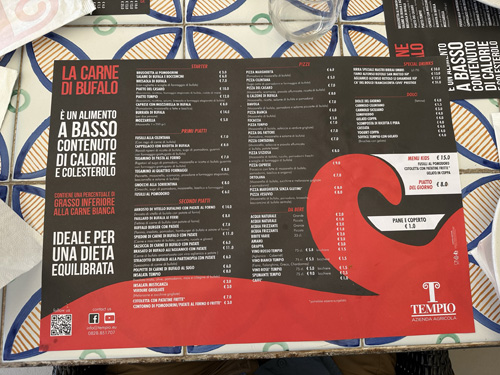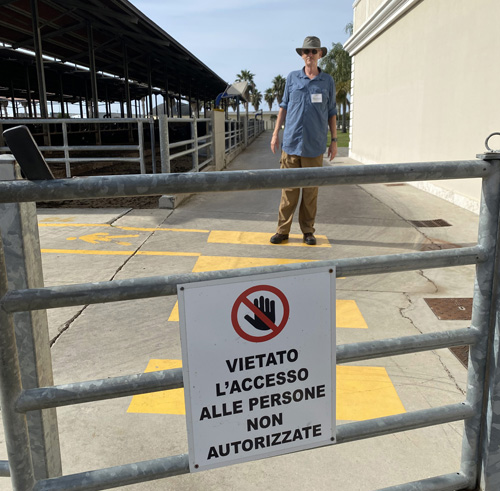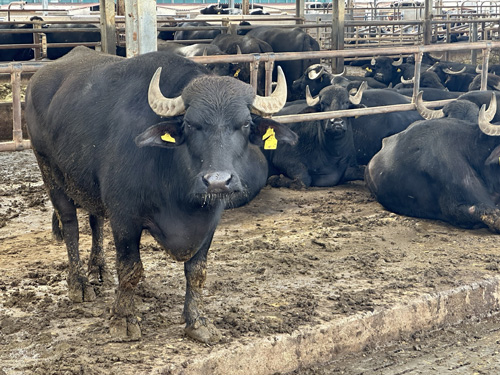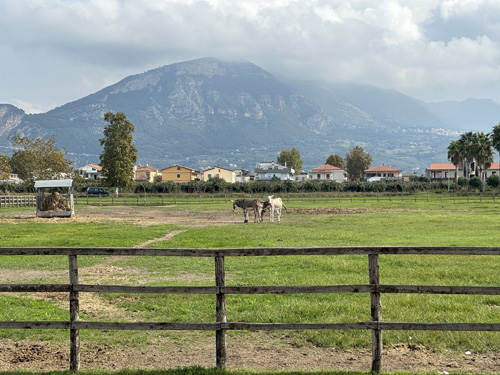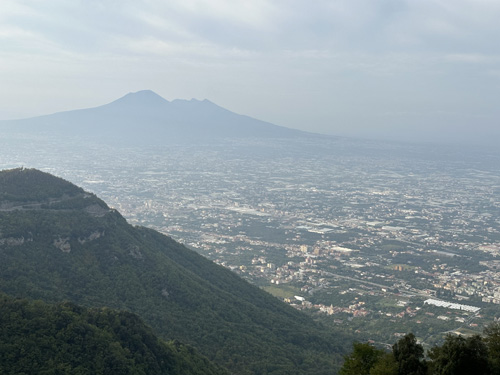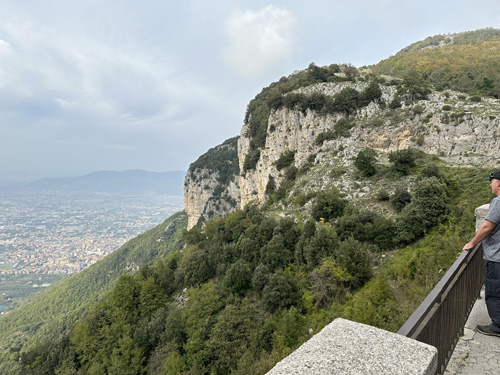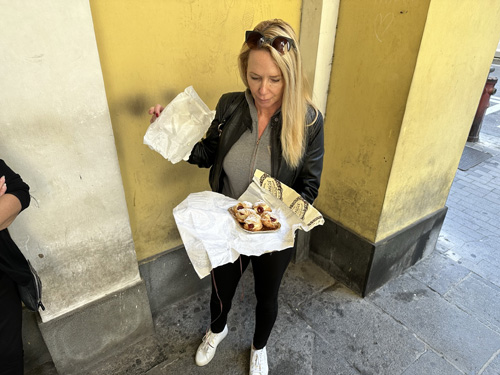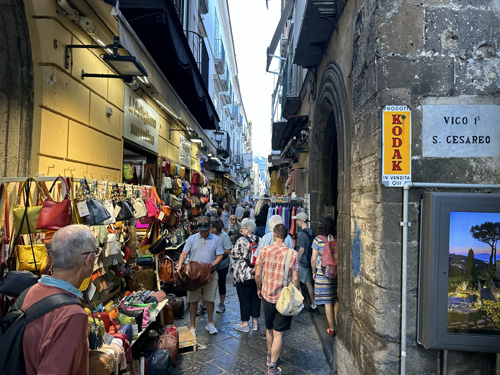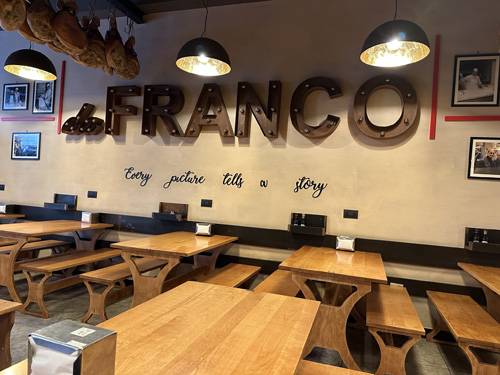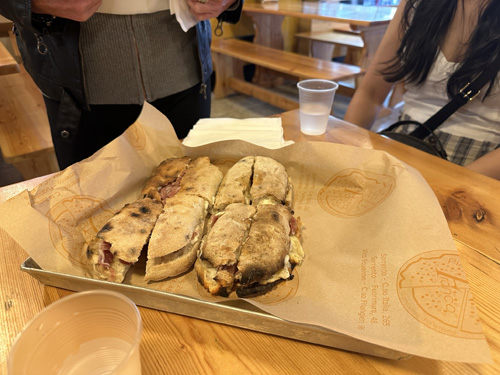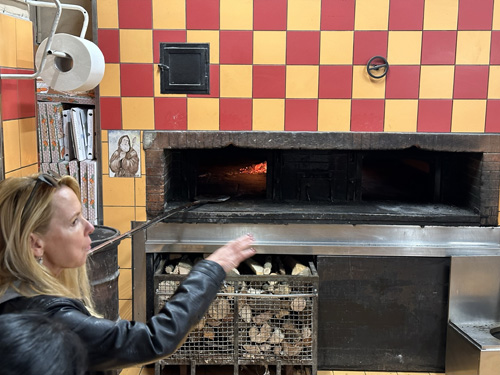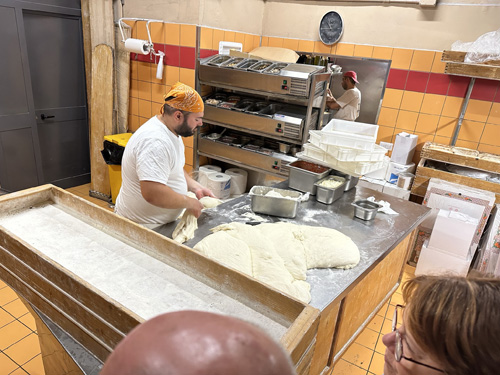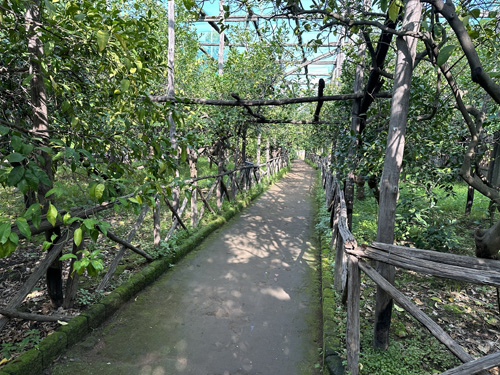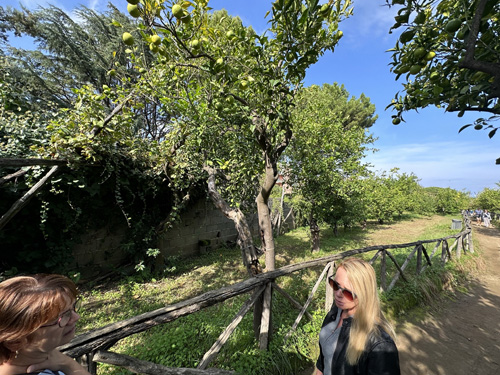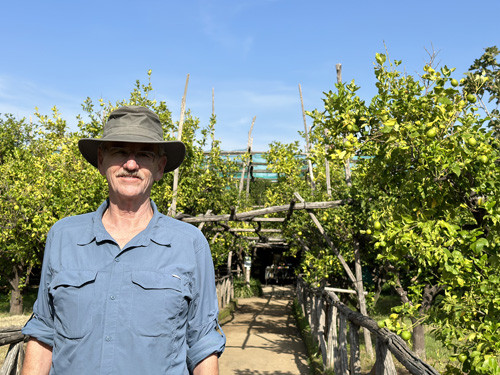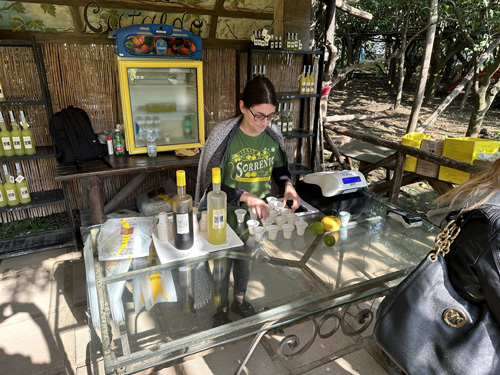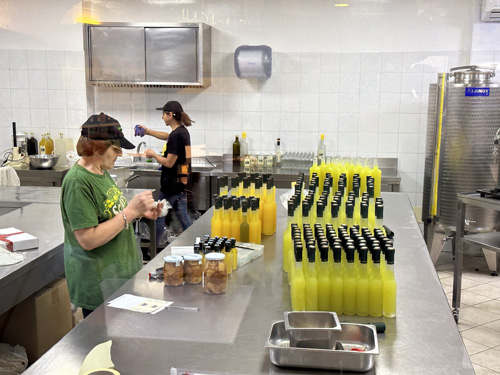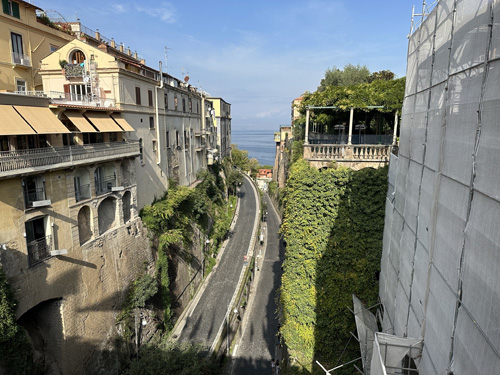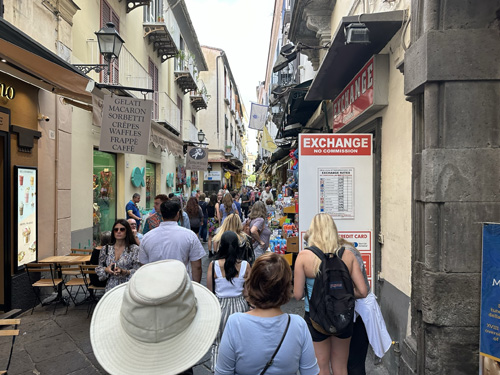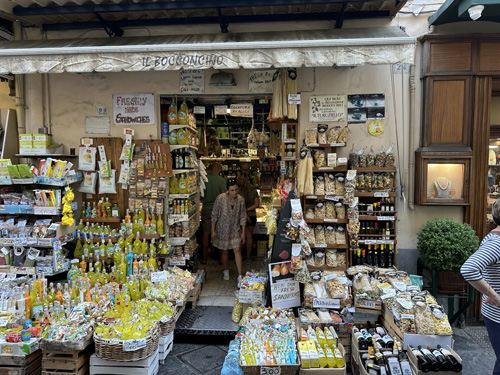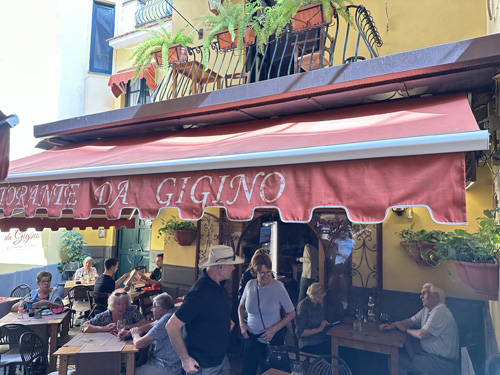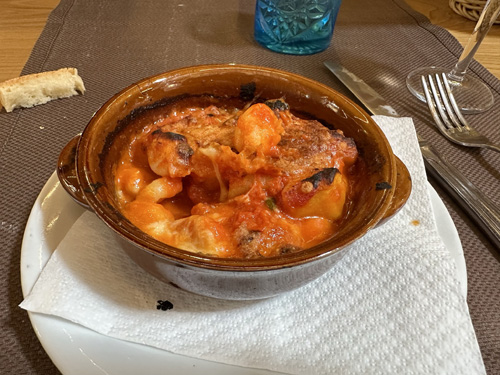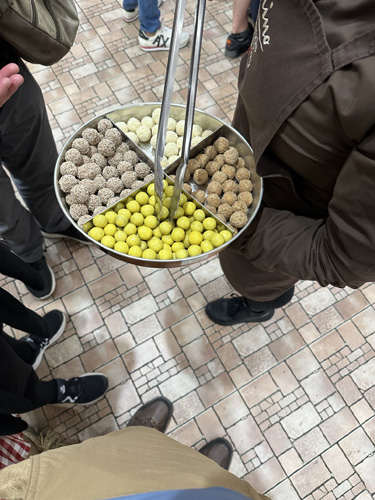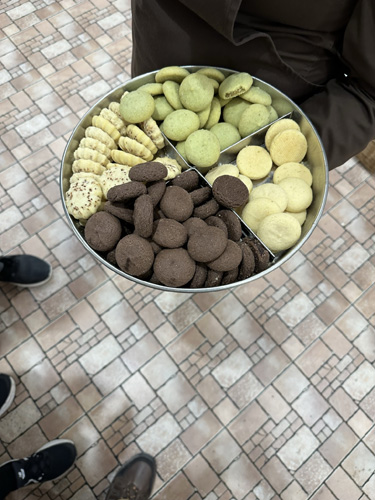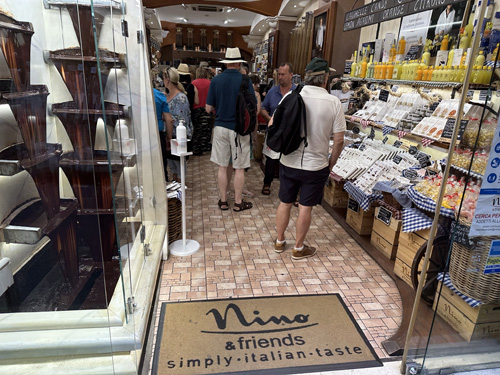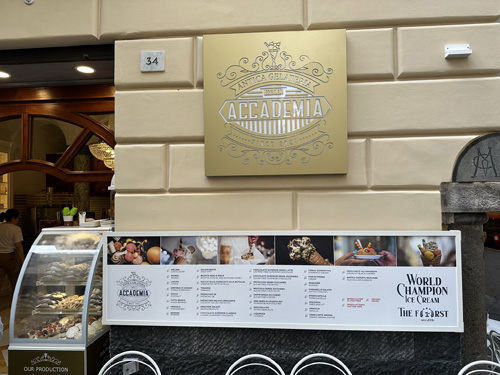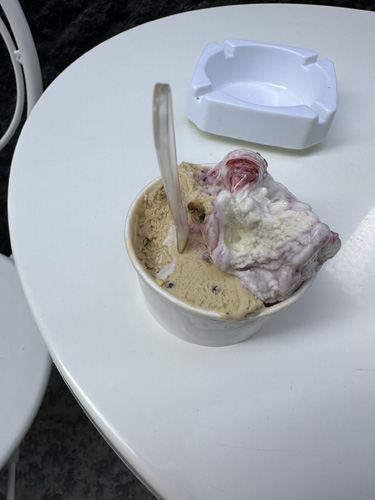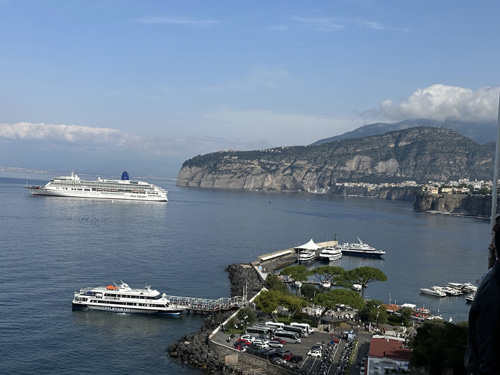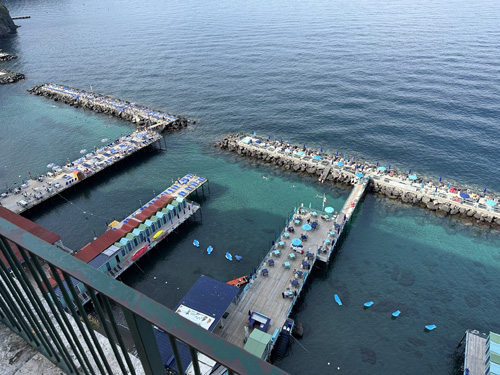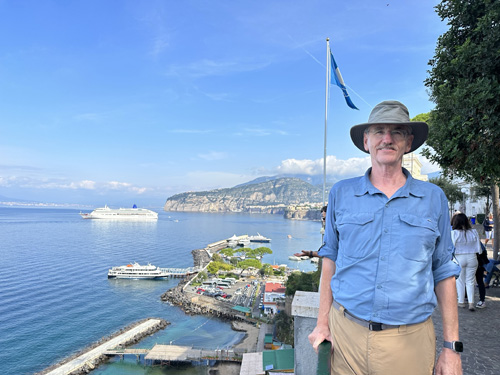Hal Jespersen's Italian Campaign Trip, October 2022
This is a continuation of Hal’s report on his trip to Italy for a tour of the World War II Italian Campaign, hosted by Stephen Ambrose Historical Tours.
This report is broken into four pages.
- Pre-tour arrival in Italy
- Sicily Campaign
- Italian Campaign: Salerno to Sorrento (this page)
- Italian Campaign: Winter Line and Anzio to Rome
Thursday, October 20 — Messina, Calabria, and Paestum
Today is a travel day. We have a late start, bags out at 9:30 for the bus at 10. This has something to do with the ferry schedule. I slept later, but still had time to enjoy the crystal clear views of the coastal towns and Etna from the hotel roof. The drive north to Messina was scenic, approximately the route of Montgomery. I lost track of how many tunnels the autostrada had to use; the usable land between the mountains and sea is super narrow and would be difficult to manueuver.
Our bus got onto the ferry with minimal fuss and the 2-mile crossing to Calabria was smooth and only about 20 minutes. We drove north for about 90 minutes and then rest-stopped at a big gas station with a couple of sandwich shops. I had a delicious Focaccia Rustica stuffed with spinach and cheese—a very generous slice for only 3.5€! Then another 4 hours through rather severely mountainous terrain and dozens and dozens of tunnels. We had another rest stop to change drivers; EU regs limit bus drivers to 4-hour segments without rests. It was a really long day.
We arrived at Hotel Ariston in Paestum, Campania, at 6:15, a really nice hotel in sort of a dead area, but not too far from the beach. Dinner was minestrone and a pot roast of buffalo, which wasn’t great. Dessert was baba au rhum, which was nicely rummed.
Friday, October 21 — Paestum and Sorrento
We have a new bus today, inconveniently a smaller one with fewer seats, tighter legroom, and inadequate luggage storage. It’s needed to accommodate narrow streets to come on the Sorrentine peninsula. We stopped near the beach at a park with small monument to the 36th ID. There we were visited by a lady named Maria who lived here as a six-year-old during the invasion and Enrico, who built the monument in 1988. Marty said that in 20 years, every tour he has led was joined by Maria. We also met a cute friendly gatto.
Next was the nearby Golden Beach, where the 36th landed. We were specifically at Green sector. We had a long discussion of the US and British landings and how Ernst J. Dawley’s VI Corps moved inland too quickly, which diluted the troops in the defensive line, and was hit by six German divisions in their counterattack down the Sele River. The 82nd Airborne was night-dropped in as reinforcements. One of our attendee’s father served in the 36th (142nd Infantry) and he told some of his father’s harrowing experiences on the beach.
Next we fell back 2,600 years to visit the ruins of the ancient city of Paestum, formed in 600 BC by the Greeks and conquered by the Romans in 273 BC. The latter completely reworked the central areas into a Roman-arranged city, but left the twelve temples intact (because they had the same gods, although named differently). We had a great guide named Adele who just happened to be there by coincidence—we had no prearrangement—so we ended up spending 30 minutes more than planned. About one sixth of the city remains. It was mostly abandoned In the Dark Ages when it became a swamp, and then locals raided buildings and statues for stones for their houses.
We saw three large temples that remain mostly standing, each of which is supposed to be better preserved than any in the world, including the Acropolis: Poseidon/Neptune (the largest and newest), Hera/Juno (the oldest), and Athena/Minerva. The columns are sandstone and were once covered with white marble-dust plaster, so they looked like the marble versions in Greece. They once had wooden roofs with terracotta tiles. Poseidon had blue lapis highlights, with minerals mined in Afghanistan! Hera was black and red and is the only remaining temple anywhere with an odd number (nine) of columns in front.
Adele described how the interiors were laid out and how they were constructed on deep bases of limestone. She guided us through the Roman forum, including ruins of a fish market, a covered market street, a political building, and a gladiator amphitheater. Excellent tour.
Lunch was hosted at a buffalo restaurant with six different buffalo cheeses, including two large balls of delicious mozzarella, buffalo salami, honey, and bruschette (toast with just the most flavorful tomatoes I have ever had). Even the ice cream was buffalo. I snuck around the back to visit a few of the beasts.
Back on the bus, we crossed over the Sele River, the center of the German counterattack, although it happened so quickly I couldn’t get my camera out. We also skipped for unstated reasons a planned stop at the Tobacco Factory, a site of heavy fighting. We motored north through predominantly agricultural areas parallel to the coast and then turned north into the mountains north of Salerno. We took a rest stop and then an accident struck: one of our guys, aged 94, took a spill and fell down, hitting his head. Pools of blood on the sidewalk and people rushing for napkins, bandages, and ice packs. We had a doctor on board and ladies who were either nurses or at least acted like them. Fortunately he didn’t lose consciousness, but an ambulance was called, arriving almost 30 minutes later. Antonella accompanied him to the hospital and we learned later he was OK and would return to us before dinner.
Our destination was Chiunzi Pass. It was the mission of three US Ranger battalions to land at Maiori on the Amalfi Coast and march north up the mountain to seize the pass. We couldn’t use the same route because our bus wasn’t allowed on the road that hugs the southern coast of the Sorrentine peninsula. So we took the autostrada north and west to Angri and then headed south to the pass. Spectacular views of the peninsula and Mt Vesuvius, although it was rather hazy for really good photos. Then a long drive back up the winding switchback road to the autostrada and west to Sorrento.
Our hotel is the Hotel Plaza Sorrento, which is pretty nice. Dinner in the hotel restaurant as usual: salad (with iceberg lettuce!), an unidentified pasta, and eggplant parmigiana. Very stingy wine service.
Saturday, October 22 — Sorrento
Today is a free day. Three choices of activities were offered by Ambrose: a tour of Pompeii, a ferry ride to the island of Capri, or an unsupervised day in Sorrento. I had done the first two on a previous trip to Italy (44 years ago!), so I opted for Sorrento and arranged through Viator yet another foodie walking tour. I found that our hotel could not have been more conveniently located for downtown touristy stuff. Our tour guide was Tamara, formerly of San Diego, and there were five guests, all US. She greeted us with sfogliatelle, a typical Campanian pastry. We started down the main drag, Corso Italia, to Pizzeria da Franco, which is a well-known place to locals. We had saltimbocca, but it wasn’t what Americans know—veal wrapped in prosciutto. Instead it was a pizza-dough sandwich (a panuozzo) with prosciutto and mozzarella. Delicious. We also went in back to see the 900° oven and pizzaioli making dough; they serve 500 pizzas a day here.
Nearby was I Gardini di Cataldo which is a lemon and orange grove right downtown. At an outdoor stand we had sip-tastings of limoncello (30% alcohol, made from the lemon rind steeped in 96% alcohol, not the juice), arancia (orange-cello), liquirizia (licorice), and Finocchietto (fennel). In the back we observed two women working in the tiny limoncello factory. We stopped at the Ravine, formed 3,700 years ago by a Vesuvius eruption somehow, and saw the original steep wall of the city on one side. We continued on the pedestrian section of the Corso and stopped at a small shop called Il Bocconcino, where we had a plate of tiny appetizers with a glass of red-label Peroni beer: speck, salami, Caciocavallo cheese (despite the name, no horses were harmed in making this cow cheese), and Provolone del Monaco (a variety made in the hills). Tamara also showed us a bottle of “Viagracello” but we did not partake.
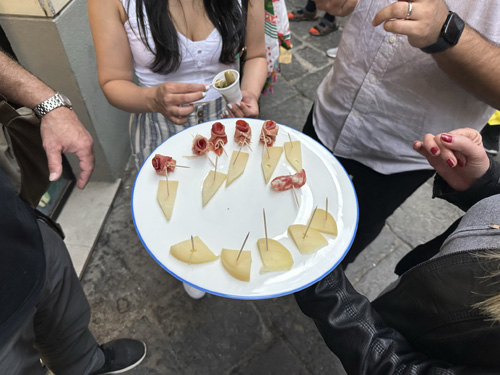
Next was lunch at Pizzeria Da Gigino. We started with a carafe of Falanghina wine, which is an interesting white wine that when served young and fresh has a frizzante quality, almost like Prosecco. When older or exported, it's flat. I believe this was one of the wines from the hotel last night, but the stingy waitress kept a towel wrapped around the label as she poured her minuscule portions. We had a caprese salad with rocket (arugula) and a baked dish with gnocchi in tomato sauce with melted cheese. A shop with touristy local food goods was next, Nino and Friends on Via S. Cesareo. We had a whirlwind of small tastes and I had trouble keeping up. But here goes: limoncello, limoncello cream, pistacchio cream (sort of a warm butter consistency), four candy balls (coconut, limoncello, salted caramel, pistacchio), a pistacchio cookie with a creamy center, white truffle powder (which we licked from our hands like cokeheads), a pesto, a paste of black truffle/mushroom/olive, anchovy paste, two different ages of balsamic vinegar (the owner has 100-year-old on hand, but no sampling of that), scorzette limone (candied lemon peel in chocolate), and two Gocces (small hard-ish candies with flavored vodka centers). Whew!
Dessert was at Antica Gelateria dell’Accademia on Via Padre Reginaldo Giuliani. Mine was a duo-cup of Salviamenta (sage and mint, quite unusual) and Pistacchio Croccante Salate (crunch salted pistachio); this place won some sort of world’s best award for their pistachio, they say. Our tour finished up at the S. Francesco waterfront, where we could see Naples and Vesuvius, although once again it was rather hazy. We also passed by an Italian wedding party (with a drop-dead gorgeous bride). Tamara said that Mondays–Fridays tourists come from the UK to get married, but Saturdays are reserved for locals.
Dinner was on our own. I tried to arrange a group to find a place, but only three of us assembled to go to Da Gigino, where I had lunch. Tonight I had a very nice Capricciosa pizza in the Neapolitan style and an interesting Aglianico Jungano red from Paestum; it rightly featured a buffalo on the label.
